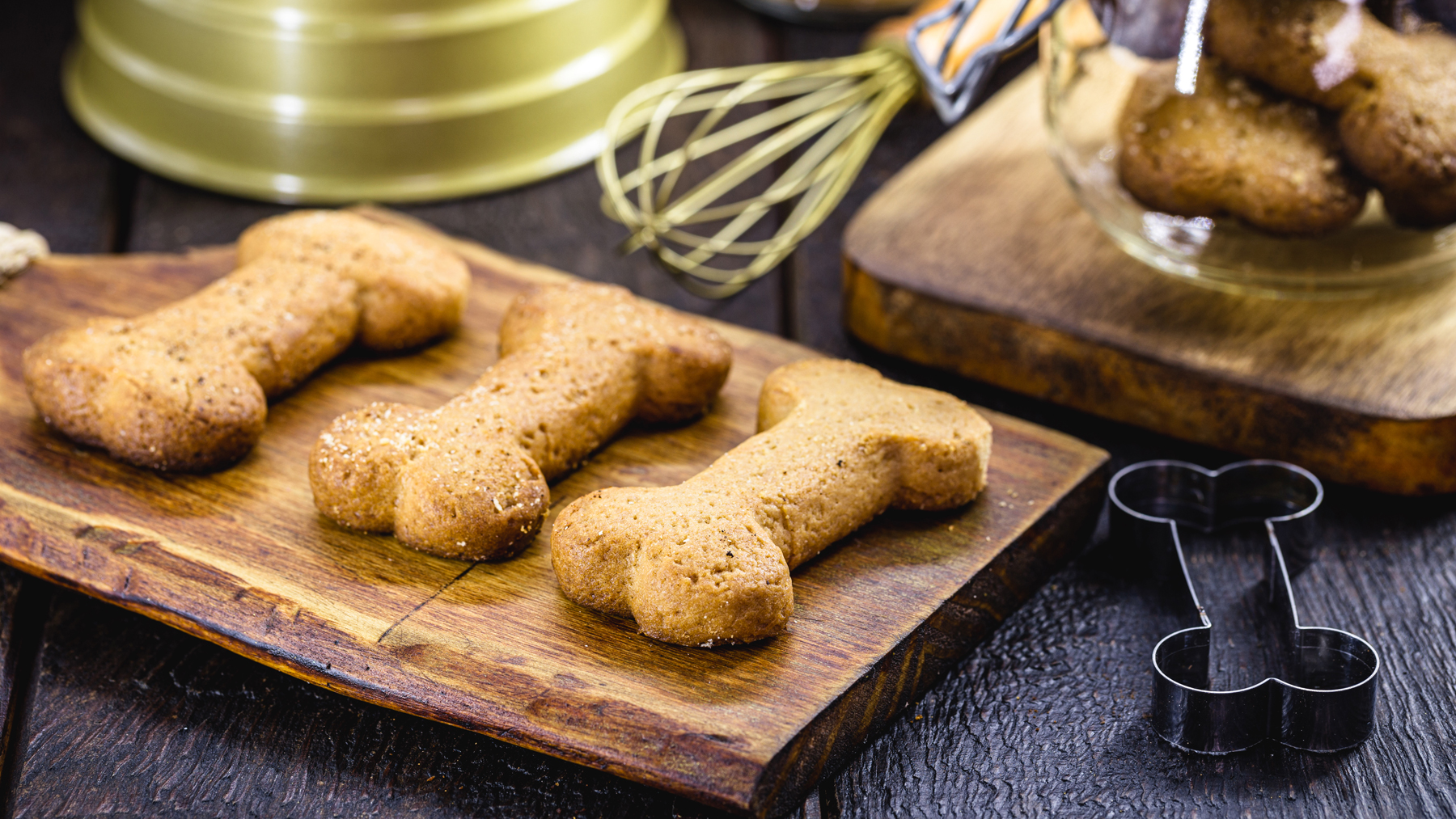
When buying treats for your canine companion, you may find yourself worried about the content of highly processed biscuits, chews and nibblets. Owners are constantly bombarded with articles and videos on what not to feed your dog, but can learning how to make homemade dog treats be a solution?
The good thing about homemade dog treats is that you know exactly what is going into them (as long as you check the ingredients in any processed elements like peanut butter). For ways to add an extra dose of nutrients and flavor to your homemade treats, check out our guide to what spices can dogs eat?
While we wouldn’t recommend overfeeding treats, it’s worth remembering even homemade treats are just that - treats - and should be given in moderation. The advice is the same for the best dog treats.
We ran our top recipes by two highly qualified experts and got their input on how safe it is to make your own homemade dog treats. Keep reading to find out which tasty homemade treat sounds best for your pet...

Sarah McNamara has been a nutritionist for 5 years and started her journey into pet nutrition thanks to her love of all animals and her passion to provide them with the correct nutrition for their individual needs and lifestyle - but also to fit the needs of the pet owner in terms of format and price point. Before branching out into nutrition, Sarah worked for an equine feed company and held positions in Livestock Animal feed manufacturing in quality control and within a laboratory setting analyzing feed and raw materials on a wet chemistry basis.

Emma graduated from the Royal Vet College in London in 2011. She has a keen interest in surgery and went on to do a postgraduate certificate in small animal surgery and was then awarded advanced practitioner status in the same discipline. When she is not practicing she provides expert commentary on behalf of Perfect Pet Insurance.
Is it safe to make your own homemade dog treats?
Barking Heads canine nutritionist Sarah McNamara explains that homemade dog treats can be a healthy part of your dog’s diet.
She encourages moderation, “Providing you use dog friendly ingredients and do not feed in excess the same as you would do with non-homemade,” she said. If you're trying to fit fruit and vegetables (that are safe for dogs to eat) into your canine's diet then mixing them into a tasty homemade recipe is a great solution.
However, McNamara notes, “It is harder to know the Kcal content of homemade treats, however, so be mindful of how many you give your pet."
We also spoke to Emma Chandley, BVetMed PGCertSAS MRCVS, who is a vet for Perfect Pet Insurance. “It is perfectly safe and acceptable to make your own dog treats as long as you are fully aware of any ingredients that are toxic or poisonous to dogs,” she advised. “Many recipes are available online, but only certain ones are vet approved. Always check with your vet before starting them on any new treats you want to make at home.”
"They can provide health benefits and if you cannot feed within a main meal or they won’t take in their natural raw form, combining healthy ingredients them into a treat format is a great way to encourage them to eat their five a day,” said McNamara. “No treats can be considered balanced as they are a complementary food if they are homemade or not and should not substitute a 100% balanced and complete meal in whichever format the pet owner provides their pet.”
Chandley highlights that although the recipes below contain balanced nutritional profile components, they don't include all the necessary ingredients that a dog needs in their daily diet. As long as you are feeding them nutritionally rich and balanced dog food then some homemade dog treats can make the perfect food reward for your beloved pup.
1. Pumpkin and peanut butter dog treats
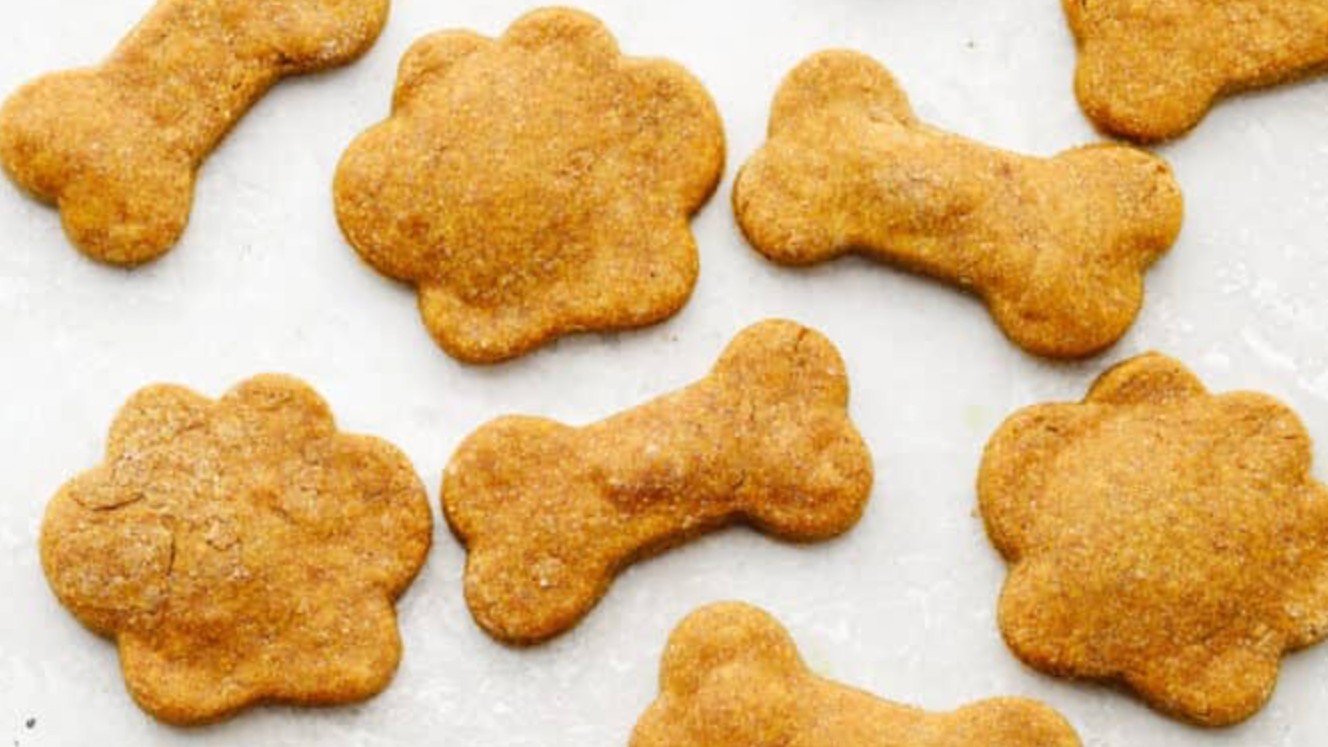
Ingredients:
- 1 cup pumpkin puree
- 1/3 cup peanut butter with no xylitol
- 2 large eggs
- 2 1/2 cups whole wheat flour
- ¾ teaspoon cinnamon
Method:
- Preheat the oven to 350° and line a baking sheet with parchment paper.
- In the bowl of a mixer use the paddle attachment to combine the pumpkin, peanut butter, and eggs at medium-high speed.
- Add in the flour and cinnamon and mix until a stiff dough has formed.
- Turn the dough out on a lightly floured surface and roll out to ¼ inch thick. Use cookie cutters to cut your desired shapes.
- Bake for about 20-25 minutes, until the edges begin to turn golden brown. Allow cooling completely.
Recipe via therecipecritic.com
Notes from the experts...
“Eggs can be an allergen, as can wheat,” said McNamara. “It is essential that owners double-check any nut butters they are using do not contain xylitol. Xylitol is toxic to dogs and can be very dangerous,” warned Chandley.
“It is essential that owners double-check any nut butters they are using do not contain xylitol. Xylitol is toxic to dogs and can be very dangerous,” noted Chandley.
2. Bacon dog treats
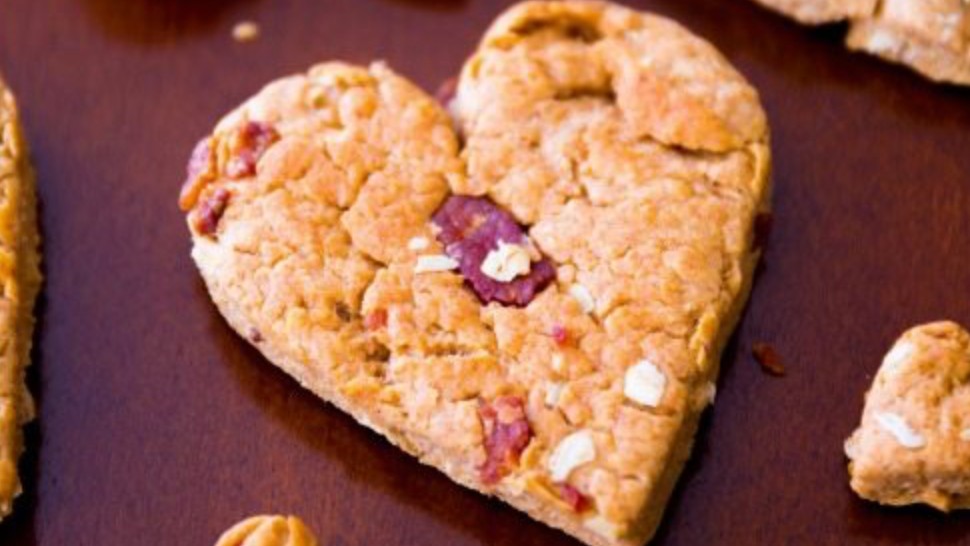
Ingredients
- 1 cup (255g) natural creamy peanut butter
- 3/4 cup (180ml) nonfat milk
- 1 large egg or 1/4 cup unsweetened applesauce
- 2 cups (244g) whole wheat flour* (spoon & leveled)
- 1 Tablespoon baking powder
- 1/3 cup (30g) oats*
- 2–3 strips cooked bacon, chopped
Method:
- Preheat oven to 325°F (163°C). Line two large baking sheets with parchment paper or silicone baking mats. Set aside.
- In a large bowl, gently mix the peanut butter, milk, and egg together with a wooden spoon or rubber spatula. Add the flour and baking powder. You may need to turn the dough out onto a floured work surface and use your hands to work in the flour. Mix in the oats and bacon. The dough is extremely thick and heavy.
- Using a floured rolling pin, cut into shapes using cookie cutters or a knife. Arrange on the baking sheets. Bake for 18-20 minutes, or until very lightly browned on the bottom. Remove from the oven, and flip the treats to bake the other side for 10-12 more minutes.
- Allow to cool completely before serving to your pup. Cover and store leftovers at room temperature for up to 1 week or in the refrigerator for up to 2 weeks.
Tips:
- Freezing Instructions: The treats freeze well up to 2 months.
- Flour: Unbleached all-purpose flour is safe for dogs, but whole wheat is more highly recommended because of its added health benefits. Please consult with your vet about any allergies your dog may have.
- Oats: Either whole-rolled or quick oats are fine.
Recipe via sallysbakingaddiction.com
Notes from the experts...
McNamara recommended using peanut butter without Xylitol for this recipe.“Swap non-fat milk for goats’ milk, this has probiotic properties and dogs struggle to digest lactose as they lack the enzyme to break this down,” she added. “Swap applesauce for just cooked mashed up apples if you can, as applesauce has quite a bit of sugar added to it.”
“Bacon is not generally recommended for dogs as it is very high in fat and salt. It also contains harmful additives such as nitrites,” said Chandley. “When the bacon is cooked at high heat, this causes the additives to form carcinogenic compounds called nitrosamines.”
3. Cheddar and bacon treats
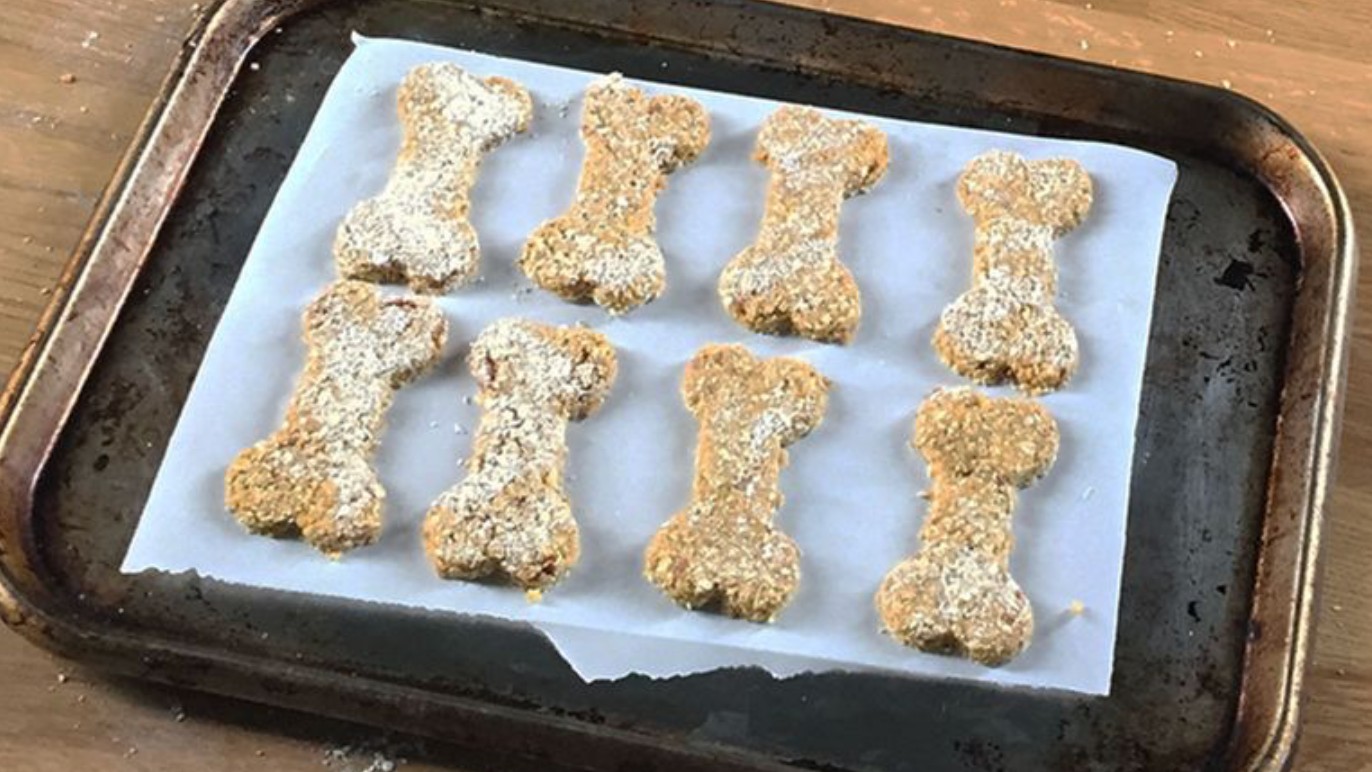
Ingredients:
- 1 ½ cups rolled oats
- ½ cup shredded cheddar cheese
- 4 strips bacon, cooked and crumbled
- 2 eggs
Method:
- Preheat oven to 350 degrees Fahrenheit.
- Add oats, cheese, and bacon to the bowl of a food processor and process until ingredients reach a crumb-like consistency.
- Add two eggs to food processor and process until mixture resembles a sticky dough.
- Sprinkle flour or finely ground oats onto a wood cutting board and roll out dough to about ¼-inch thick. Using a cookie cutter, cut out dough into desired shape.
- Transfer dog treats to a parchment-lined baking sheet and cook for 20 minutes.
- Cool treats completely and store in an airtight glass or plastic container.
Recipe via goodhousekeeping.com
Notes from the experts...
“Cheese provides calcium to support teeth and bones when fed in moderation. It also is a source of Vitamin B12" said McNamara but she also warned, "Be careful with eggs and remember cheese can be quite fattening,” said McNamara. “If they have a dairy intolerance/sensitivity, maybe skip this one."
Chandley said that cheese is fine for dogs, "As long as it does not contain too much salt and your dog is not lactose intolerant.”
4. Calming dog treats
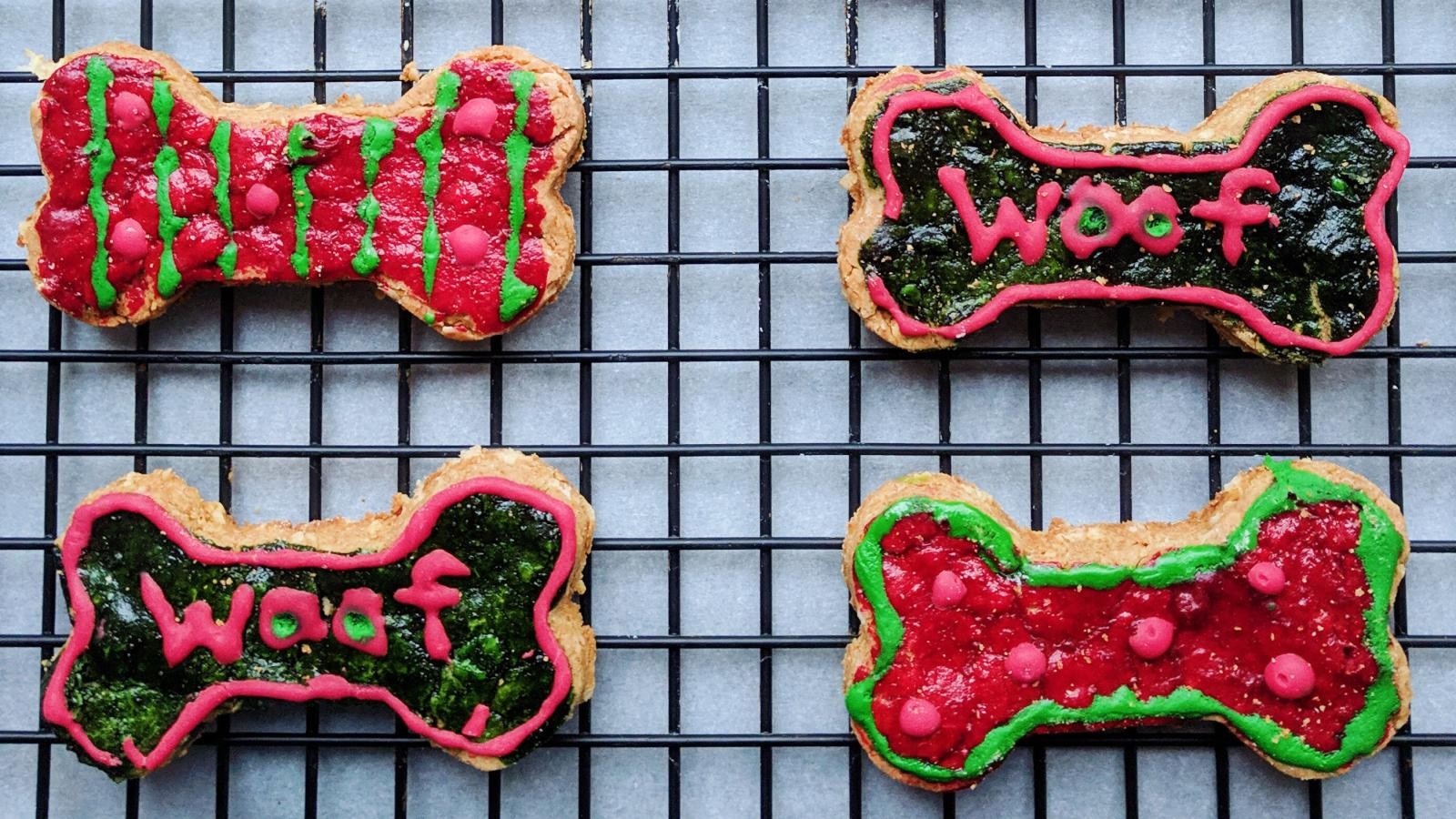
Ingredients for the cookies:
- ½ cup creamy peanut butter
- ⅓ cup milk
- 3 tablespoons unsweetened applesauce
- 1 cup whole wheat flour
- ½ tablespoon baking powder
- 3 tablespoons oats
Calming ingredients:
- 1 tablespoon edible lavender buds OR
- 1 tablespoon chamomile powder
Ingredients for the icing:
- 1 egg yolk, beaten
- Bit of water (about ¼ teaspoon)
- Food coloring (optional)
Method:
- In a large bowl mix the peanut butter, milk, and applesauce together.
- In a smaller, separate bowl, mix the flour and baking powder together.
- Add the flour mixture to the peanut butter mixture and stir well.
- Turn the mixture out onto a lightly floured surface.
- Using your hands, gently knead the oats and lavender or chamomile into the dough.
- Once you have a nice, compact ball of dough, press the dough into a rectangle (about ½ an inch thick). Because of the crumbliness of this dough, using your hands to press out the dough will be easier than a rolling pin. The warmth from your fingers aids the process.
- Using your desired cookie cutter, cut the dough into biscuits.
- Place onto an ungreased cookie sheet.
- Next, mix the egg yolk and a bit of water together. Divide into small bowls and add food coloring to achieve the desired colors.
- Brush the “icing” on to the unbaked biscuits using a pastry brush or the back of a spoon.
- Bake at 325 degrees for 30 minutes.
- Remove from oven and allow to cool completely.
Recipe via animalhumanesociety.org
Notes from the experts...
“Swap milk for goats’ milk and applesauce for cooked mashed apples,” suggests McNamara.
“Lavender contains small amounts of linalool. This compound is toxic to dogs. It is only found in small concentrations, so toxicity is seldom an issue. If a dog were to ingest large quantities, though, it would cause a problem,” said Chandley. “Chamomile can be toxic to your dog if ingested in large amounts or repeatedly over a long period of time. It can cause gastrointestinal upset and, in severe cases, bleeding disorders.
Most human-grade food colourings, which are non-alcohol based, are safe for dogs. It is important to check food colouring doesn't have any xylitol in it,” she added.
5. Apple carrot treats
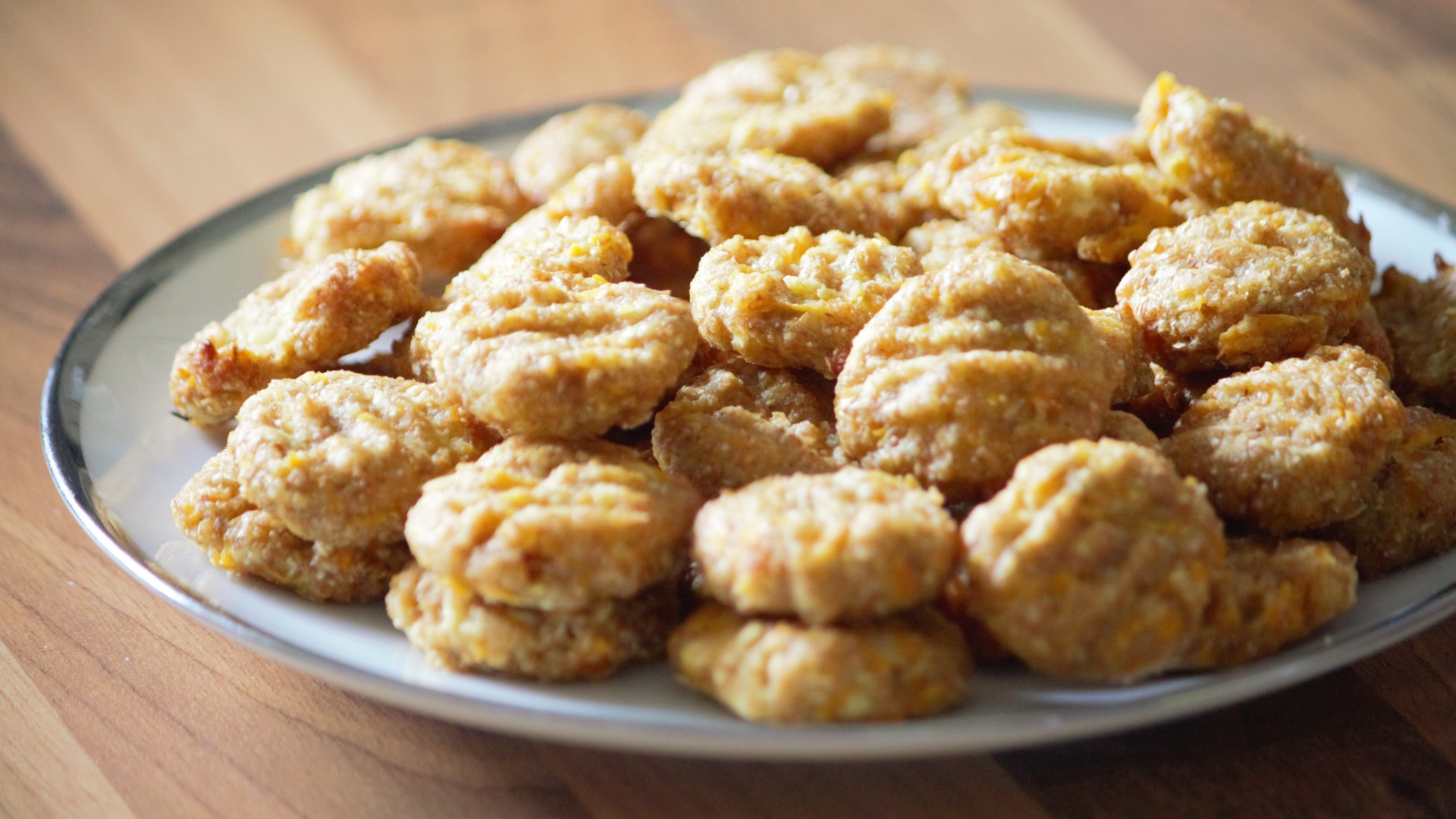
Prep time: 10 minutes
Baking time: 15-18 minutes
Makes 90 nibbles or 22 doughnuts
Ingredients
• 1 large carrot, grated (approx. 4oz)
• ½ apple, grated
• 1 ½ cups whole-wheat flour
• ½ cup unsweetened apple sauce
• 1 egg
• Plain natural yogurt (optional)
• Ground cinnamon (optional)
Method:
• Add ingredients to a bowl and mix to form a dough
• Wrap dough in clingfilm and chill in the fridge for an hour or two
• Preheat oven to 350°F/180°C and line two large baking trays with parchment
• For small ‘nibbles’, roll a teaspoon of mixture between your palms, place on a baking tray and press down gently with the back of a fork. For doughnuts, scoop a tablespoon of mixture, roll between your palms, press down on a baking tray and make a hole in the centre with the end of a paintbrush or teaspoon
• Bake nibbles for 15 minutes, doughnuts for 18 minutes
Optional steps:
• Dip doughnuts in plain yogurt to create ‘frosting’ and sprinkle with a small pinch of ground cinnamon
• Place in freezer for 20 minutes to allow the yogurt to set
Tips:
Don’t be surprised if the dough is wet and sticky, but you can add a few more tablespoons of flour if it’s really unmanageable. If you’re after more of a biscuit texture, try squeezing some of the moisture out of the grated carrot and apple before adding to the mixture.
These can be kept in a refrigerator for up to a week.
Notes from the experts...
“Carrots provide beta carotene known to support vision,” said Mcnamara.
“Apples are safe to feed to dogs as long as they have removed the pips and core. The pips contain cyanide which is toxic to dogs,” said Chandley.
6. Chicken and rice bones
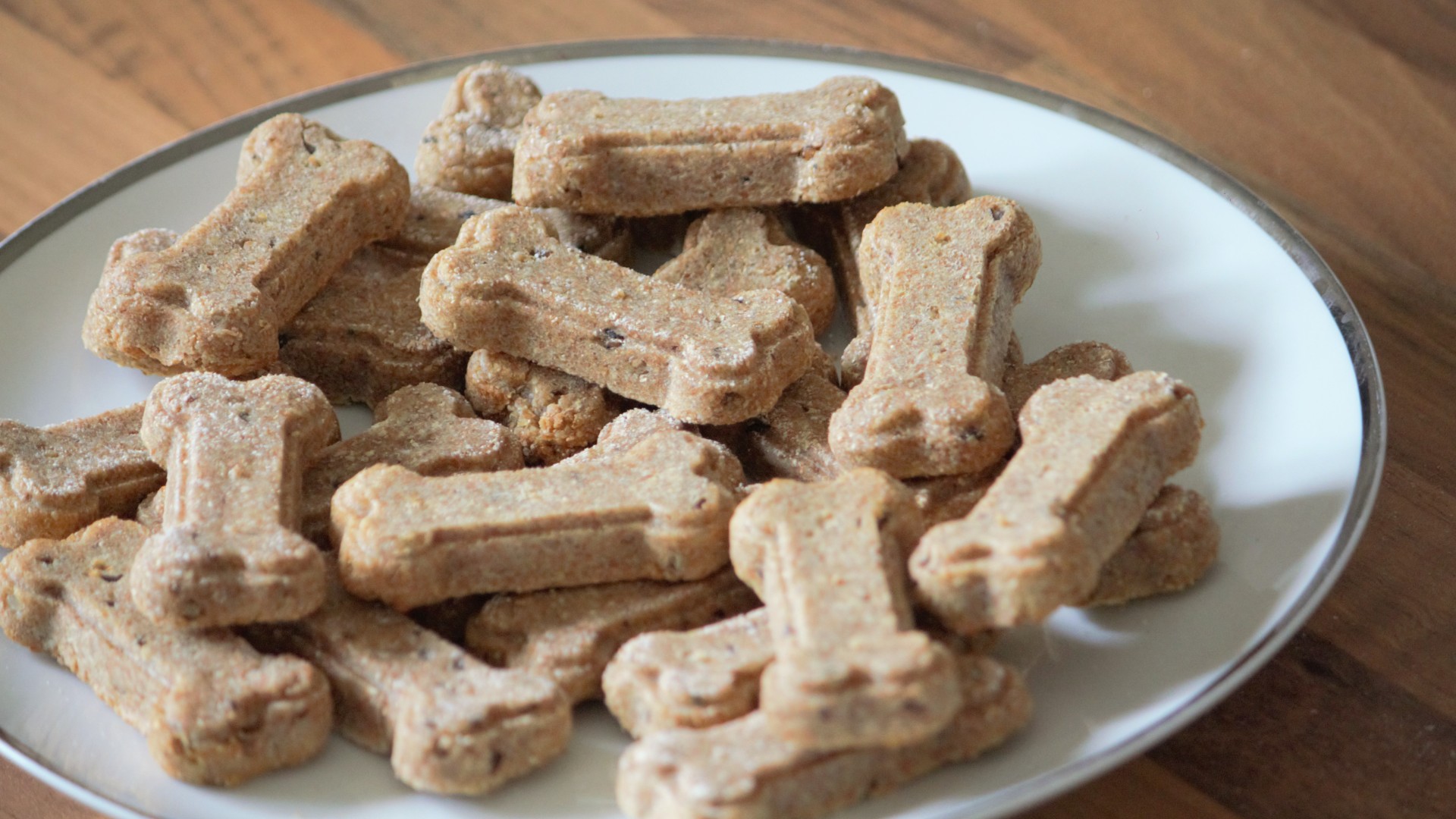
Prep time: 30 minutes
Bake time: 25 minutes
Makes 22-24 bones
Ingredients
• 7oz raw chicken breast (boneless, skinless)
• 500ml chicken stock
• ½ cup cooked rice (white and wild rice mix)
• 1 ½ cups wholewheat flour
• 1 egg
Method
• Add chicken breast and stock to a pan and boil until chicken is cooked – about 10 minutes
• Remove chicken from stock and leave both to cool
• Preheat oven to 350°F/180°C
• Add rice, chicken and ⅓ cup chicken stock to a food processor and blend to a paste
• Add chicken paste, flour and egg to a bowl and mix to form a dough
• Add a tablespoon of dough to each well of a silicon mould and press down until evenly spread
• Bake for 25 minutes until light brown
• Allow to cool down and firm up before removing from the mould
Tips
If you don’t have a silicone mould, roll the dough out on a lightly floured surface and cut out with a cookie-cutter, or roll a tablespoon of dough between your palms and press down slightly on the tray.
Rice is a great treat option for older dogs or dogs with easily upset stomachs – it’s nutritious but bland enough for their digestive systems to handle.
These can be kept in a refrigerator for up to a week.
Notes from the experts...
“Chicken and rice are considered a gentle combination and low in fat for those watching their weight. Chicken is a lean source of protein for growth and repair of muscles,” said McNamara.
7. Peanut butter banana bites
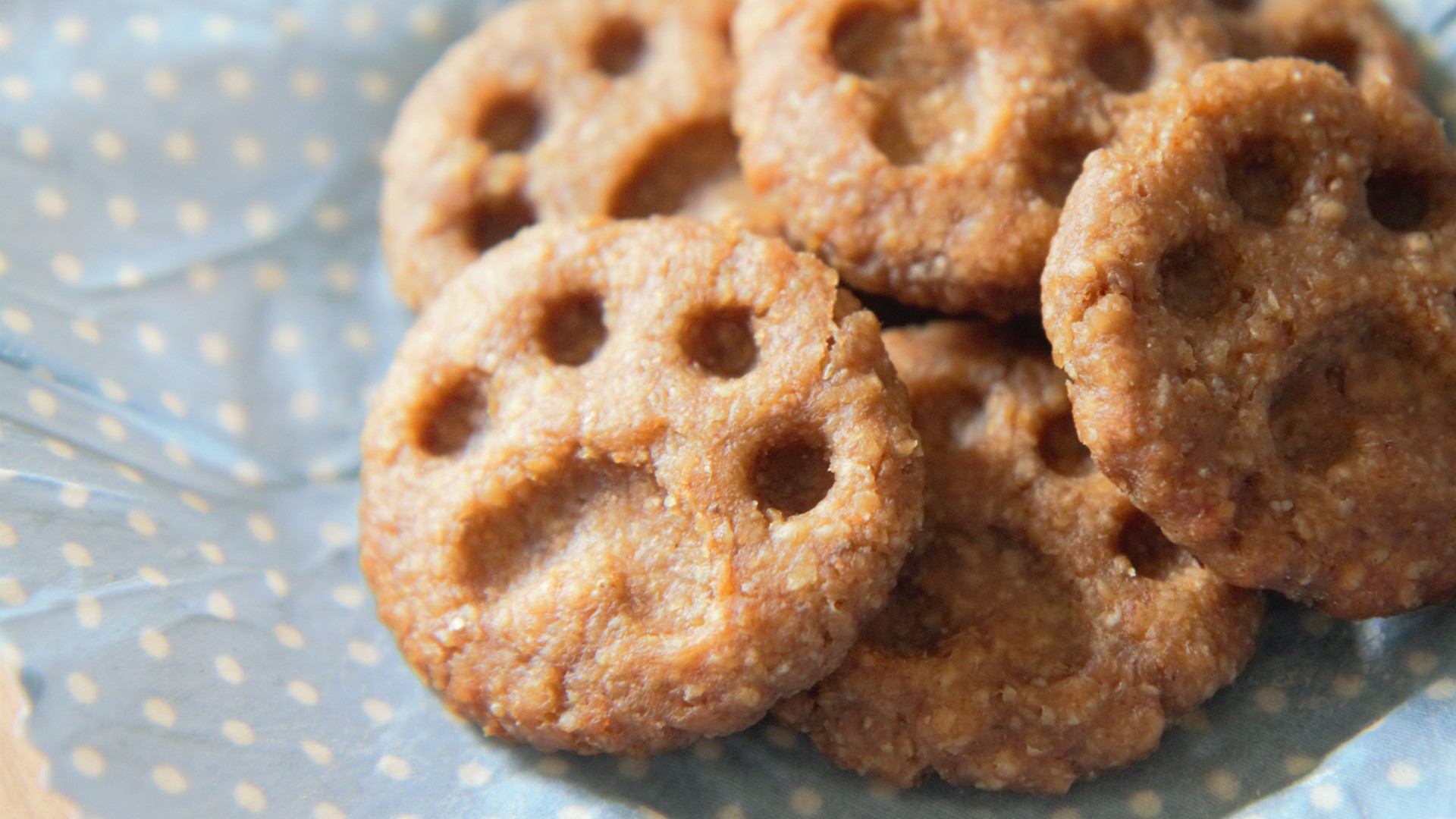
Prep time: 5 minutes
Bake time: 12-15 minutes
Makes about 24 bites
Ingredients
• 1 large or 2 medium bananas
• ½ cup natural unsweetened peanut butter (xylitol free)
• 1 ¼ cup rolled oats
Methods
• Mash banana(s) in a bowl
• Add peanut butter and stir well
• Whizz oats in a food processor until it looks like flour
• Add oat flour to bowl and mix to form a dough
• Wrap dough in clingfilm and chill in the fridge for an hour
• Preheat oven to 350°F/180°C and line two large baking trays with parchment
• Roll a tablespoon of mixture between your palms, place on a baking tray and press down slightly – leave about ¼ inch between each biscuit
• Use the end of a paintbrush (or the tip of your little finger) to press a paw shape into each biscuit
• Bake for 12-15 minutes until the bottoms are light brown
• Leave to cool down before giving to your dog or storing in an airtight container
Tips:
These can easily be made into bite-sized treats instead of biscuits – just measure out a teaspoon of mix for each one rather than a tablespoon. In their mini form, these irresistible peanut butter treats make perfect training rewards.
These can be kept in a refrigerator for up to a week.
Notes from the experts...
“Oats can help keep your dog feeling fuller for longer,” commented McNamara
8. Blueberry pupsicles
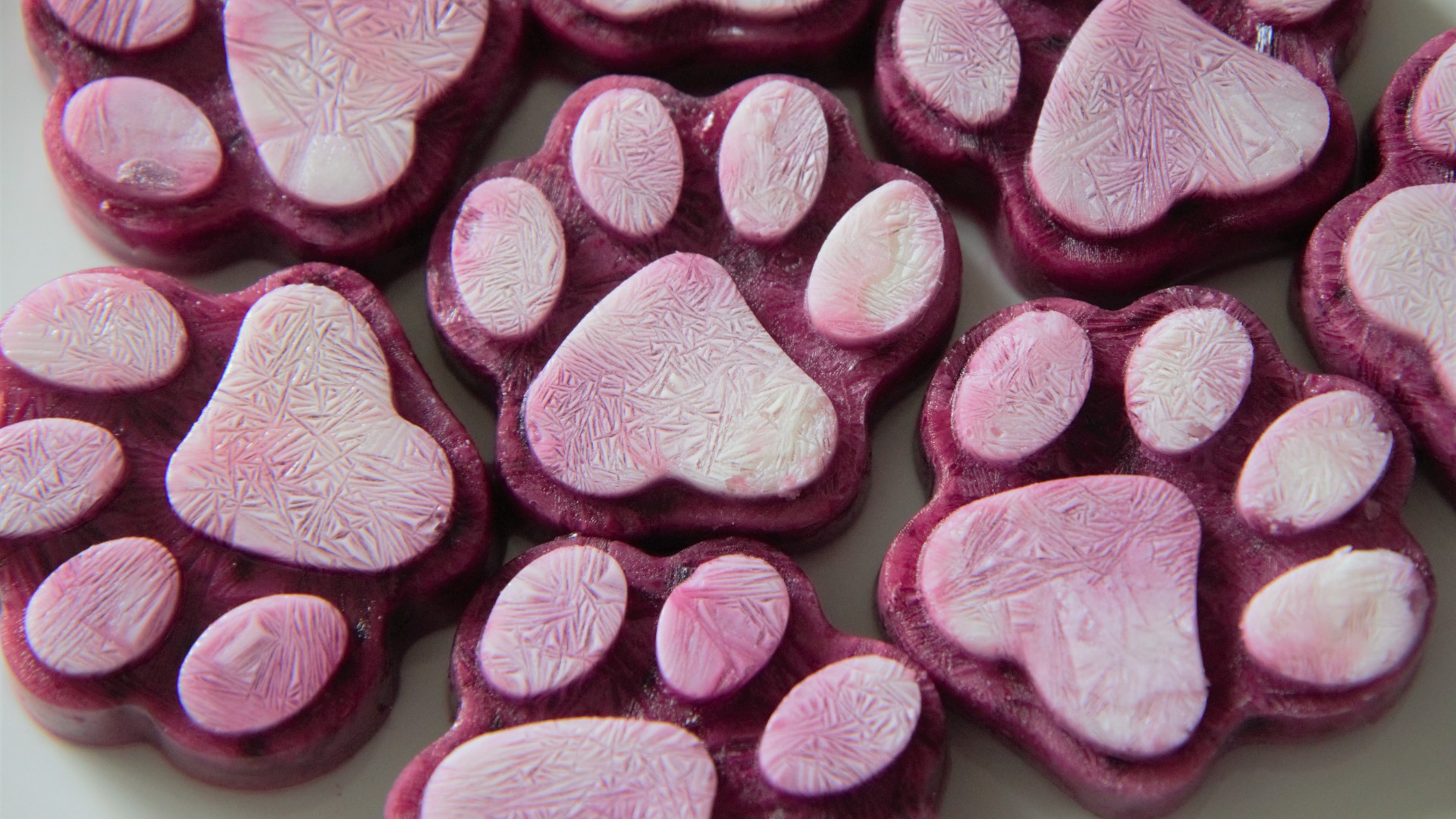
Prep time: 5-10 minutes
Freeze time: 5+ hours
Makes 8 pupsicles
Ingredients
• 2.5oz plain natural yogurt
• 2.5oz water
• 2.5oz unsweetened frozen blueberries
Method
• Blend yogurt, blueberries and water in a food processor
• (Optional step) Fill paw pads of silicone with some plain yogurt
• Pour blueberry yogurt mix into moulds until almost full (the pupsicles will expand as they freeze)
• Freeze for at least five hours
Tips:
This recipe can be adapted endlessly – try using frozen strawberries or watermelon instead of blueberries, adding the blueberries whole instead of blending them, or adding peanut butter to the watery yogurt mix.
If you need to keep the calories down, use a little less yogurt and make up the weight with extra water.
For more frozen dog treats recipes visit our DIY guide.
Notes from the experts...
“Blueberries are packed with natural antioxidants and can have cancer fighting properties, and natural Yoghurt is great for gut health and contains probiotics (live bacteria) to help increase the health population of bacteria which work to digest food appropriately and therefore absorb nutrients which can also have a whole-body effect in terms of aiding the immune system,” said McNamara
Are the homemade treats suitable for big and small dogs?
McNamara encourages dog owners to be mindful of their dog’s activity levels when feeding any treats, including homemade dog treats. “Smaller active dogs and puppies will require more Kcal per day for growth and also for small dogs depending on their exercise level than a medium dog even at the same exercise level,” she said.
“It is thought small dogs are typically more energetic and need more Kcals to keep up with the energy expenditure. On the flip side, elderly dogs who do not have good mobility need fewer Kcals to avoid becoming overweight and putting pressure on old joints.”
You might also want to try our dog pancake recipe.
PetsRadar Newsletter
Get the best advice, tips and top tech for your beloved Pets

Lou is an experienced writer and keen dog lover who works at PetRadar's sister sites, LiveScience, Fit And Well and Coach. When Lou isn't covering health and fitness, she's busy spending time with her rescue lurcher, Dixie, horse riding or growing all kinds of veggies and flowers on her allotment.
Lou grew up with dogs and got her first dog in 2023 after many months of searching. Dixie is a six-year-old brindle greyhound lurcher (with lots of saluki mixed into her DNA too). Dixie was very uncertain and nervous when she first came home with Lou, who is her third owner, but after lots of time and care, she is now a happy, confident dog (with lots of canine and human friends!)
